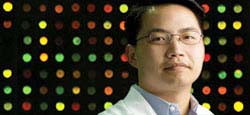April 15, 2008 - By Amy Adams
Making rare cells available to researchers could hasten work on better cancer treatments

Howard Chang and his team found that activating certain genes in skin cells transforms them into cancer stem cells that can form tumors in mice.
With a bit of genetic trickery, researchers at the School of Medicine have turned normal skin cells into cancer stem cells, a step that will make these naturally rare cells easier to study.
Cancer stem cells are thought to be the ones that drive a cancer, and are therefore the targets of any cancer therapy that must kill them in order to be effective. Understanding these cells has been a challenge, however, because they are rare, difficult to isolate and don't grow well in the lab.
Howard Chang, MD, PhD, assistant professor of dermatology and senior author of the work, said being able to generate cancer stem cells from normal cells will help move forward that research on new cancer therapies. 'The upshot is that there may be a way to directly create cancer stem cells in the lab so you don't always have to purify these rare cells from patients in order to study them directly,' he said. The work was published in the April 10 issue of the journal Cell Stem Cell.
The study also demonstrated that cancer stem cells are much more similar to the stem cells found in embryos, which can develop to form all tissue types, than they are to the more-restricted adult stem cells. This finding has important implications for understanding how cells go awry when they become cancerous.
Cancer stem cells were first discovered in 1994 by researchers at the University of Toronto. In 2003, Michael Clarke, MD, who was then at the University of Michigan, discovered cancer stem cells in the first solid tumor, breast cancer in this case, showing that the concept of cancer stem cells wasn't restricted to blood cancers. Clarke has since moved to Stanford, where he is the Karel H. and Avice N. Beekhuis Professor in Cancer Biology, and Stanford has become a leader in cancer stem cell research, with teams finding cancer stem cells in head and neck cancer, colorectal cancer and additional blood cancers. Laboratory researchers at the medical school are also beginning to work with clinical groups to see if they can apply cancer stem cell findings to patient care.
One question among cancer stem cell researchers has been how those cells originate. 'By the time a patient comes to a hospital, they already have a cancer, so that process has already happened,' said Chang, who is also a member of the Stanford Cancer Center. Generating cancer stem cells in the lab gives scientists insight into how the transformation happens and could lead to new ways of either stopping the transformation early on or detecting and destroying those cells once they form.
Chang and first author David Wong, MD, PhD, postdoctoral scholar, began to answer the question of how cancer stem cells originate by comparing genetic activity in embryonic stem cells with the genetic activity in normal adult stem cells. The researchers found a large group of genes that were active only in embryonic stem cells. They then looked at which genes were active in cancer stem cells and found that the pattern resembled that of embryonic stem cells.
The finding was a surprise, given that once embryonic stem cells become committed to forming adult cells, such as skin, brain or blood, they were thought to forever deactivate those embryonic genes. Instead, Chang said this work suggests that when those adult cells become cancerous, they may turn those embryonic genes back on.
The group also noticed that the genes active in both embryonic and cancer stem cells are controlled by a few biological master regulators. One of those genes, called Myc, has also been shown recently to help convert normal skin cells into embryonic-like cells.
By activating two genes in addition to Myc in normal skin cells, those cells were transformed into what appeared to be cancer stem cells. When they were transplanted into laboratory mice, the cells formed tumors, one hallmark of a true cancer stem cell.
From here, Chang and Wong hope to learn more about how these genes activate a cancerous cell state. 'Our particular interest is in using this approach to find the mechanism that turns a normal cell into a cancer stem cell,' said Chang, who is also the Kenneth G. and Elaine A. Langone Scholar of the Damon Runyon Cancer Research Foundation.
Other Stanford researchers who contributed to this work include medical student Helen Liu; Todd Ridky, MD, PhD, instructor in dermatology, and David Cassarino, MD, assistant professor of pathology.
The work was funded by grants from the National Institutes or Health, the American Cancer Society and a Dermatology Foundation Research Career Development Award to David Wong.
About Stanford Medicine
Stanford Medicine is an integrated academic health system comprising the Stanford School of Medicine and adult and pediatric health care delivery systems. Together, they harness the full potential of biomedicine through collaborative research, education and clinical care for patients. For more information, please visit med.stanford.edu.